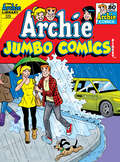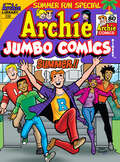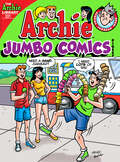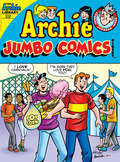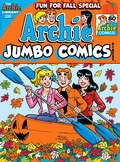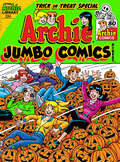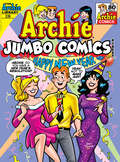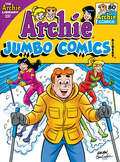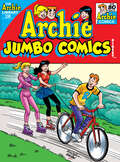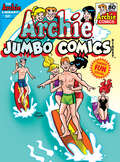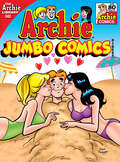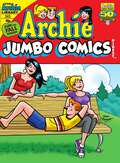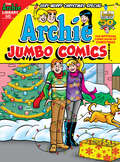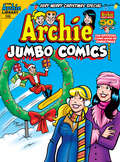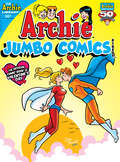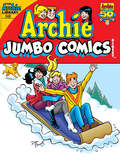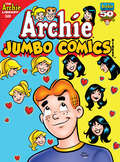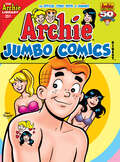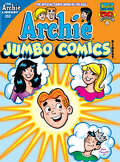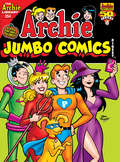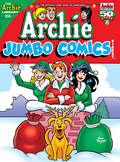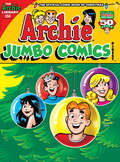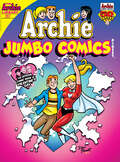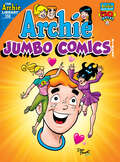- Table View
- List View
Archie Double Digest #329 (Archie Double Digest #329)
by Archie SuperstarsBRAND NEW STORY! Archie tries to become a YouTube star by recording a series of “How To” tutorials. Each one turns out to be a disaster, forcing him to change his title from “how to” to “How NOT To!”
Archie Double Digest #330 (Archie Double Digest #330)
by Archie SuperstarsBRAND NEW STORY! “Jurassic Farce!” Travel back in time to the world of ‘Archie 1’! A prehistoric version of Archie and the gang have been noticing how many traffic jams there are with all the dinosaurs clogging up the roadways. There has to be another way to remedy this situation! Cue caveman genius Dilton, who’s devised a system of air travel featuring the pterodactyls. What could possibly go wrong?!
Archie Double Digest #331 (Archie Double Digest #331)
by Archie SuperstarsFEATURING TWO BRAND NEW STORIES! First, “Volley Folly” Chuck has an idea for a side hustle on the beach—he wants to paint custom volleyballs! He gives a free sample to Jughead in hopes that Jug will talk it up and promote it. The ball has Jughead’s face painted on it and Jug loves it. But soon after, Jughead notices weird things are starting to happen, like whenever the ball gets hit, Jughead feels it! Is there more to this novelty volleyball than meets the eye? Then, Bingo Wilkin returns in “Bad Blood Buds”! When Samson and Willie (Samantha and Bingo’s dads) are in feud mode, Bingo and Samantha declare that their true love will prevail in the face of adversity. An idea is born, and the two dads decide to act like best pals to see if that might derail their kids’ romance, since nothing else has worked. With tensions mounting in Samantha and Bingo’s romance as their dads begin to get along, Bingo is in need of some sage advice: enter Jughead Jones, Bingo’s cousin! Can he help salvage their romance and put an end to their fathers’ constant feuding? Maybe after lunch and a long nap.
Archie Double Digest #332 (Archie Double Digest #332)
by Archie SuperstarsTWO BRAND NEW STORIES! First, Trev and Archie are getting into parkour but it seems like a lot of effort to Jughead for not much of a return. Will he jump into this new trend or let it fly past him? Then, in “What a Twyst!” Trula Twyst is always trying to understand the male psyche, especially Jughead’s! Learning the power of hypnotism, she tries to hypnotize Jughead into opening up about his real feelings for her!
Archie Double Digest #333 (Archie Double Digest #333)
by Archie SuperstarsTWO BRAND NEW STORIES! First, “3 Goes Into Three…” three is the magic number in this special 333rd issue! And you know what has three sides? A triangle! And triangles are important to Riverdale—well, at least one is: Archie, Betty, and Veronica’s love triangle! But triangles aren’t the only special shapes in Riverdale, see what other geometrical figures pop up in this fun story! Then, in “Case of the High Grade Hacker!” An internet threat known only as “Pseudo” has come to Riverdale. They’re attacking school databases, and wiping out all students’ grading data. Worried that this will cause Archie to have to repeat the school year, he enlists the help of Detective Sam Hill to crack down on this hacker!
Archie Double Digest #334 (Archie Double Digest #334)
by Archie SuperstarsTWO BRAND NEW STORIES! First in “A Very Cosmo Halloween!” Cosmo the Merry Martian—or someone who looks an awful lot like Cosmo—crashes the Lodge Halloween Ball. Fortunately, this year it’s science fiction-themed! Cosmo tries to warn the teens of an impending invasion—but will they be able to tell them apart from the costumed aliens at the party? Then, in “Here Come the Power Pets!” The Superteens battle an evil villain called Snowboy. As Snowboy uses his powers to put the Superteens in a deep freeze, Archie’s beloved dog Vegas realizes that he’s got to find a way to rescue them. He gathers Vader, Hot Dog and Carmel and convinces them to join him. Our new heroes become the Power Pets, but do they have what it to rescue their humans?
Archie Double Digest #336 (Archie Double Digest #336)
by Archie SuperstarsBRAND NEW STORY! In “Resolution Impossible!” the gang makes a New Year’s resolution to not to lie or exaggerate. To oversee this, Veronica’s cousin Marcy is to watch over them. In a week’s period, the team that lies the least is the winner. Can they keep up with their resolution for longer than a week? And does Marcy have what it takes to keep them all in line?
Archie Double Digest #337 (Archie Double Digest #337)
by Archie SuperstarsTWO BRAND NEW STORIES! First, in “The Ghost Of Grimloch Island,” Superheroes The Shield and Wizard have sent the Boy Buddies to investigate rumors of a ghost on Grimloch Island. Little Archie, who often goes fishing on the island, has made friends with its sole inhabitant—a hermit called Harry. Harry isn’t happy about these ghostly rumors. He doesn’t want his peaceful island overrun by tourists and ghost-hunters. Can Little Archie team up with Harry to scare the Boy Buddies away? Finally, in “Detective for a Day,” Archie and Jughead happen to walk right into the middle of a fight scene between Fu Chang and a gang of criminals. As Fu Chang takes them down, Archie and Jughead’s eyes widen with excitement and decide right then that they, too, want to be awesome crime-fighting detectives like him! Will they be able to learn from the master, or will they get under his skin before he can give them a taste of the detective life?
Archie Double Digest #338 (Archie Double Digest #338)
by Archie SuperstarsTWO BRAND NEW STORIES! First, in “The Beast of Bolling Bay,” Something shatters a rowboat on Bolling Bay, almost drowning two fishermen. Was it a giant turtle or some other unidentified sea monster? Assuming there must be a logical explanation, Mr. Lodge hires Captain Valor to investigate and suggests he take Little Archie as a local guide since he and his friends often fish the area. Will Captain Valor, Little Archie and his friend Little Ambrose be able to find out the truth about the “monster”? Next, in “The Most Heroic Villain,” The Fox is at the mercy of Mr. Smile, when his son Ghost Fox comes to save the day! Except Mr. Smile has a secret weapon—Evil Heart! Watch the two teen masked crusaders go head-to-head to see whose powers reign supreme!
Archie Double Digest #341 (Archie Double Digest)
by Archie SuperstarsTWO BRAND NEW STORIES! First, a new viral FlipFlop dance has taken over Riverdale, and it’s all anyone wants to do at Veronica’s pool party. There’s just one problem: it’s a couple’s dance. Poor Ethel doesn’t know who to team up with—Jughead or her new crush Charlie? Then, in “Twister Trauma,” Captain Flag and Pureheart are battling Tom Twister—a super-villain with the ability to turn into a tornado-like creature! Tom Twister’s primary target: the post office! Can the two heroes stop him from whipping up a mail-storm?!
Archie Double Digest #342 (Archie Double Digest #342)
by Archie SuperstarsTWO BRAND NEW STORIES! First, in “Movie Mishap,” famous director Steven Squealberg is directing a movie and using Lodge Mansion as the backdrop. The movie is based on the true story of an international gang of criminals. Archie, Jughead, Betty and Veronica are all excited to be extras in the movie, but when a few other background actors are a little too good playing their roles, they’re going to need a real detective on the case: enter, FU CHANG! Then, in “Shop until you Drop,” MAD DR. DOOM is up to his old tricks! This time his plan is to attack what everyone values most—their phones! The BOY BUDDIES are on the case—unless Little Archie and the gang distract them too much!
Archie Double Digest #343 (Archie Double Digest #343)
by Archie SuperstarsTWO BRAND NEW STORIES! GHOST FOX, the heroic son of THE FOX makes his return to Riverdale and tries to keep a low profile, while rancher Nevada Jones teaches Archie and the gang an important lesson in self-reliance.
Archie Double Digest #345 (Archie Double Digest #345)
by Archie SuperstarsTWO BRAND NEW STORIES! First, CHRISTMAS IS CANCELED!? When Ethel reads a rumor online that Santa won’t be delivering presents to Riverdale this year, everyone is up in arms! Could this be true or is it just internet misinformation? Then, the Shield enlists Archie in finding a dangerous artifact before the winter celebration becomes a disaster!
Archie Double Digest #346 (Archie Double Digest #346)
by Archie SuperstarsTWO BRAND NEW STORIES! First, will Jaguar be able to tighten his belt in time to save Christmas, or is it up to Jughead and Archie? Buckle up for this one, it’s sure to be a bumpy ride! Then Moose helps the gang in a holiday marathon event to benefit sight-impaired children, cohosted by Carla Teal. But this isn’t your standard marathon—it’s filled with traps and obstacles galore!
Archie Double Digest #347 (Archie Double Digest)
by Archie SuperstarsTWO BRAND NEW STORIES! First, meet: HEARTBREAKER in his first appearance! Sabrina has accidentally released Heartbreaker, the Anti-Cupid, upon Riverdale! Will Sabrina be able to capture him before he ruins Valentine’s Day for everyone? Then, Moose appears to choose practicing for the Big Game over planning a Valentine’s surprise for Midge—until he reveals her surprise on the football field!
Archie Double Digest #348 (Archie Double Digest #348)
by Archie SuperstarsTWO BRAND NEW STORIES! First, Bingo Wilkin’s new song has gone viral! Unfortunately, the song is so popular that Bingo can’t go out in public without being swarmed by fans. How will he manage to celebrate his anniversary with Samantha? Maybe Archie and Jughead can help! Then, Archie saves the day for Shield with the super-power of super-fandom!
Archie Double Digest #349 (Archie Double Digest #349)
by Archie SuperstarsBRAND NEW STORY! ARCHIE has been selected as the first human high school student to attend a prestigious outer space high school! What will life… more importantly high school life… be like in outer space?
Archie Double Digest #351 (Archie Double Digest #351)
by Archie SuperstarsBRAND NEW STORY! Move over, Scooby Doo, the new mystery-solving team is here. Fran Frazer (and introducing her crime-fighting cat Stinger) is on the case with Archie and friends. Can they save the old beach theme park, or will they be scaredy cats?
Archie Double Digest #352 (Archie Double Digest #352)
by Archie SuperstarsBRAND NEW STORY! Sabrina hosts a monster movie night on the beach with Archie and friends, but her nemesis, Amber Nightstone, has other plans!
Archie Double Digest #353 (Archie Double Digest #353)
by Archie SuperstarsBRAND NEW STORY! In the fast-paced, ever-changing world of modern slang, how do you keep up with everyone’s spectacular vernacular? Join us for a lesson in today’s grooviest terms. (Kids still say groovy, right?)
Archie Double Digest #354 (Archie Double Digest #354)
by Archie SuperstarsBRAND NEW STORY! The annual Halloween party at Eyegore Estates seems scarier than ever! That’s because the mischievous sprites Trick and Treat have turned evil! Will their pranks ruin Halloween forever?
Archie Double Digest #355 (Archie Double Digest #355)
by Archie SuperstarsBRAND NEW STORY! The students at Riverdale High put their money together to buy a very expensive first edition book for Ms. Grundy for Christmas. But did they make a mistake in choosing Archie to wrap it for her? He might need a little Christmas magic to get the job done!
Archie Double Digest #356 (Archie Double Digest #356)
by Archie SuperstarsBRAND NEW STORY: Wilbur Wilkin is hosting a Christmas party—and everyone’s invited! It’s going to be a Secret Santa gift exchange for the ages, but when Archie’s rivalry with Wilbur amps up, will everyone get what they want?
Archie Double Digest #357 (Archie Double Digest #357)
by Archie SuperstarsBRAND NEW STORY: “Now That STINGS!” There’s an indoor flower show taking place in a huge greenhouse in Riverdale. But things are about to get buzzing when a madman known as the Murder Hornet crashes the event! It’s up to Pureheart and The Fly to save the day!
Archie Double Digest #358 (Archie Double Digest #358)
by Archie SuperstarsBRAND NEW STORY: The MLJ Museum is proud to welcome the New Crusaders for an event that’s sure to be magical, except they’re nowhere to be found! That’s not the only weird thing going on. Does anyone else think that those toys look a little TOO lifelike? If only there was a teenage witch around to help spell out what’s really going on.
